A Business Report on the Transformation of the Global Art Industry
VerifiedAdded on 2023/01/12
|11
|3088
|34
Report
AI Summary
This report investigates the changes in the global art industry, highlighting significant growth driven by online markets and evolving consumer behavior. It examines the rise of online art sales, the impact of social media on art discovery, and shifts in auction dynamics. The report also compares current trends with past expectations, noting the increasing importance of digital platforms and the expanding reach of art to broader audiences. While challenges remain, such as brand recognition and customer trust in online transactions, the art industry is experiencing robust growth, particularly in regions like the US, UK, and China. The study recommends that artists and online platforms focus on enhancing their online presence and engaging with diverse cultural communities to further stimulate growth and innovation in the art market. Desklib provides students access to a wide array of solved assignments and resources for further study.
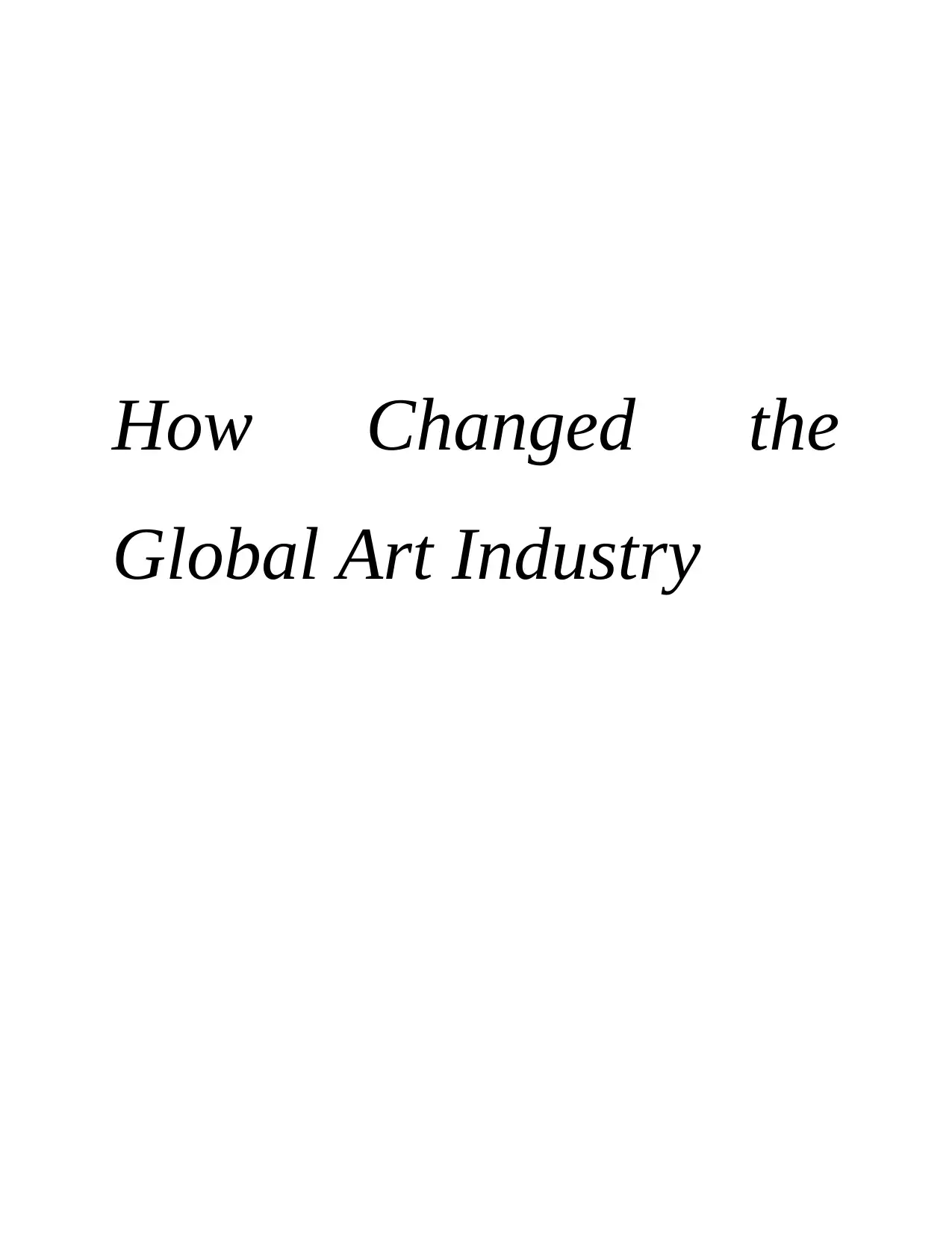
How Changed the
Global Art Industry
Global Art Industry
Paraphrase This Document
Need a fresh take? Get an instant paraphrase of this document with our AI Paraphraser
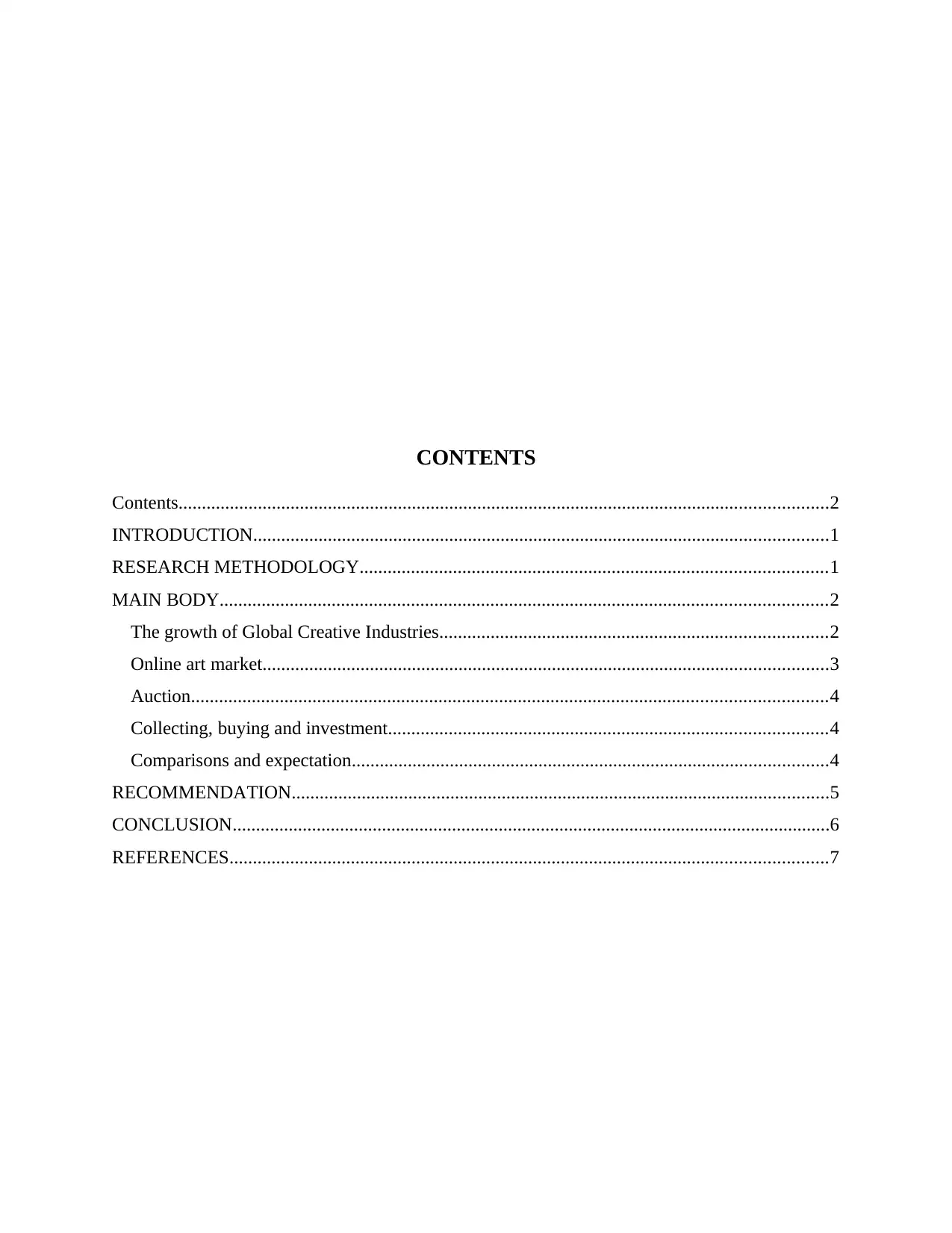
CONTENTS
Contents...........................................................................................................................................2
INTRODUCTION...........................................................................................................................1
RESEARCH METHODOLOGY....................................................................................................1
MAIN BODY..................................................................................................................................2
The growth of Global Creative Industries...................................................................................2
Online art market.........................................................................................................................3
Auction........................................................................................................................................4
Collecting, buying and investment..............................................................................................4
Comparisons and expectation......................................................................................................4
RECOMMENDATION...................................................................................................................5
CONCLUSION................................................................................................................................6
REFERENCES................................................................................................................................7
Contents...........................................................................................................................................2
INTRODUCTION...........................................................................................................................1
RESEARCH METHODOLOGY....................................................................................................1
MAIN BODY..................................................................................................................................2
The growth of Global Creative Industries...................................................................................2
Online art market.........................................................................................................................3
Auction........................................................................................................................................4
Collecting, buying and investment..............................................................................................4
Comparisons and expectation......................................................................................................4
RECOMMENDATION...................................................................................................................5
CONCLUSION................................................................................................................................6
REFERENCES................................................................................................................................7

⊘ This is a preview!⊘
Do you want full access?
Subscribe today to unlock all pages.

Trusted by 1+ million students worldwide
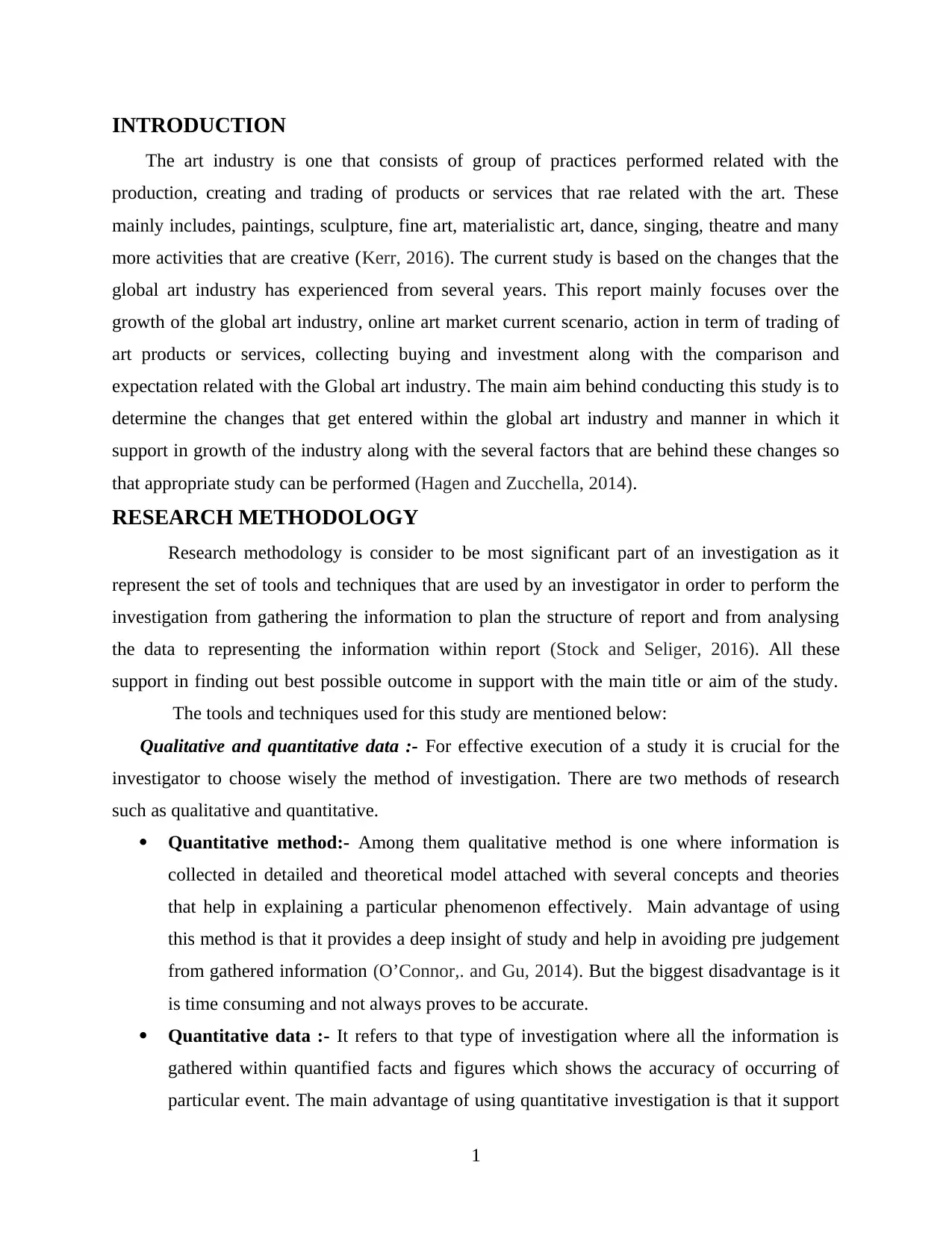
INTRODUCTION
The art industry is one that consists of group of practices performed related with the
production, creating and trading of products or services that rae related with the art. These
mainly includes, paintings, sculpture, fine art, materialistic art, dance, singing, theatre and many
more activities that are creative (Kerr, 2016). The current study is based on the changes that the
global art industry has experienced from several years. This report mainly focuses over the
growth of the global art industry, online art market current scenario, action in term of trading of
art products or services, collecting buying and investment along with the comparison and
expectation related with the Global art industry. The main aim behind conducting this study is to
determine the changes that get entered within the global art industry and manner in which it
support in growth of the industry along with the several factors that are behind these changes so
that appropriate study can be performed (Hagen and Zucchella, 2014).
RESEARCH METHODOLOGY
Research methodology is consider to be most significant part of an investigation as it
represent the set of tools and techniques that are used by an investigator in order to perform the
investigation from gathering the information to plan the structure of report and from analysing
the data to representing the information within report (Stock and Seliger, 2016). All these
support in finding out best possible outcome in support with the main title or aim of the study.
The tools and techniques used for this study are mentioned below:
Qualitative and quantitative data :- For effective execution of a study it is crucial for the
investigator to choose wisely the method of investigation. There are two methods of research
such as qualitative and quantitative.
Quantitative method:- Among them qualitative method is one where information is
collected in detailed and theoretical model attached with several concepts and theories
that help in explaining a particular phenomenon effectively. Main advantage of using
this method is that it provides a deep insight of study and help in avoiding pre judgement
from gathered information (O’Connor,. and Gu, 2014). But the biggest disadvantage is it
is time consuming and not always proves to be accurate.
Quantitative data :- It refers to that type of investigation where all the information is
gathered within quantified facts and figures which shows the accuracy of occurring of
particular event. The main advantage of using quantitative investigation is that it support
1
The art industry is one that consists of group of practices performed related with the
production, creating and trading of products or services that rae related with the art. These
mainly includes, paintings, sculpture, fine art, materialistic art, dance, singing, theatre and many
more activities that are creative (Kerr, 2016). The current study is based on the changes that the
global art industry has experienced from several years. This report mainly focuses over the
growth of the global art industry, online art market current scenario, action in term of trading of
art products or services, collecting buying and investment along with the comparison and
expectation related with the Global art industry. The main aim behind conducting this study is to
determine the changes that get entered within the global art industry and manner in which it
support in growth of the industry along with the several factors that are behind these changes so
that appropriate study can be performed (Hagen and Zucchella, 2014).
RESEARCH METHODOLOGY
Research methodology is consider to be most significant part of an investigation as it
represent the set of tools and techniques that are used by an investigator in order to perform the
investigation from gathering the information to plan the structure of report and from analysing
the data to representing the information within report (Stock and Seliger, 2016). All these
support in finding out best possible outcome in support with the main title or aim of the study.
The tools and techniques used for this study are mentioned below:
Qualitative and quantitative data :- For effective execution of a study it is crucial for the
investigator to choose wisely the method of investigation. There are two methods of research
such as qualitative and quantitative.
Quantitative method:- Among them qualitative method is one where information is
collected in detailed and theoretical model attached with several concepts and theories
that help in explaining a particular phenomenon effectively. Main advantage of using
this method is that it provides a deep insight of study and help in avoiding pre judgement
from gathered information (O’Connor,. and Gu, 2014). But the biggest disadvantage is it
is time consuming and not always proves to be accurate.
Quantitative data :- It refers to that type of investigation where all the information is
gathered within quantified facts and figures which shows the accuracy of occurring of
particular event. The main advantage of using quantitative investigation is that it support
1
Paraphrase This Document
Need a fresh take? Get an instant paraphrase of this document with our AI Paraphraser
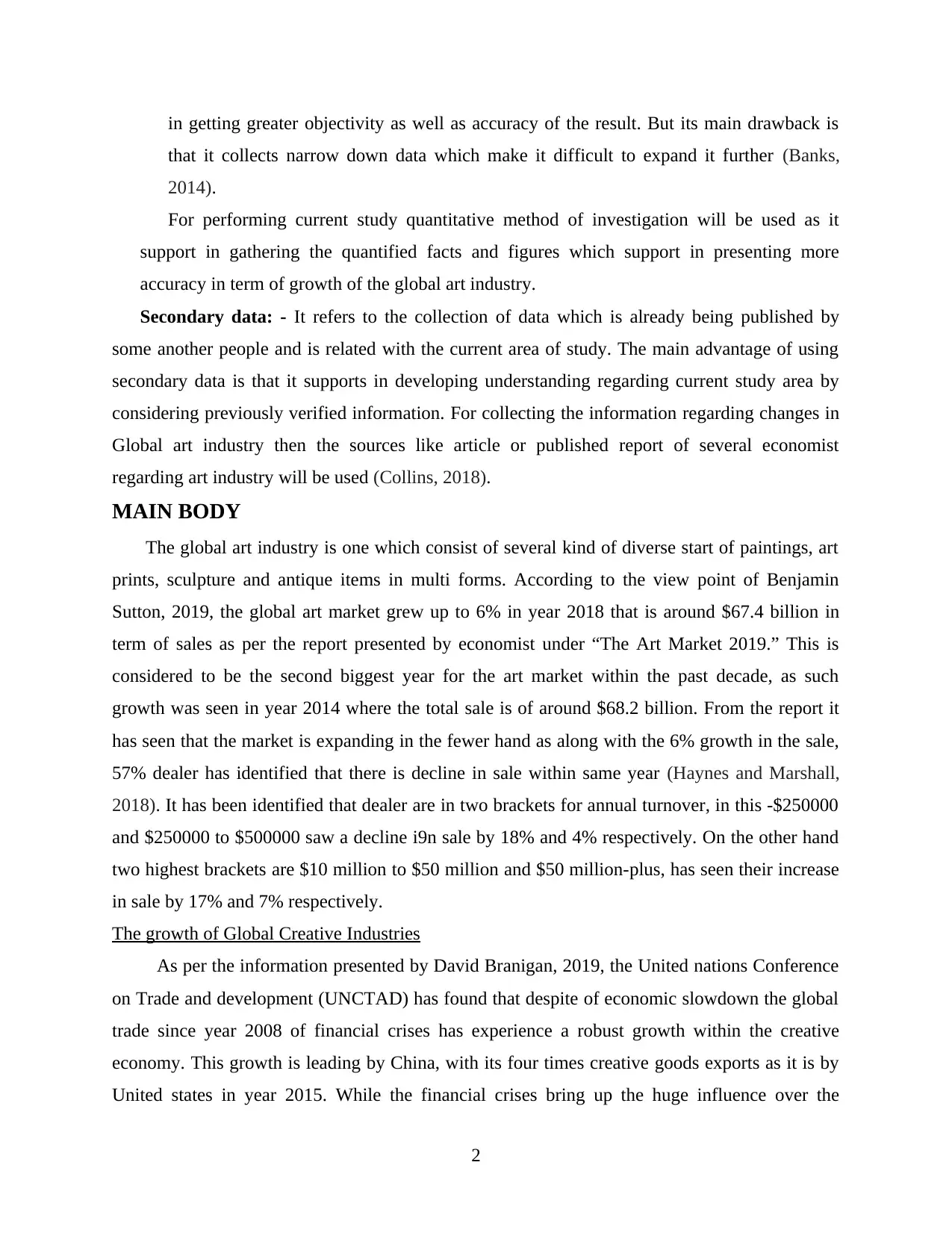
in getting greater objectivity as well as accuracy of the result. But its main drawback is
that it collects narrow down data which make it difficult to expand it further (Banks,
2014).
For performing current study quantitative method of investigation will be used as it
support in gathering the quantified facts and figures which support in presenting more
accuracy in term of growth of the global art industry.
Secondary data: - It refers to the collection of data which is already being published by
some another people and is related with the current area of study. The main advantage of using
secondary data is that it supports in developing understanding regarding current study area by
considering previously verified information. For collecting the information regarding changes in
Global art industry then the sources like article or published report of several economist
regarding art industry will be used (Collins, 2018).
MAIN BODY
The global art industry is one which consist of several kind of diverse start of paintings, art
prints, sculpture and antique items in multi forms. According to the view point of Benjamin
Sutton, 2019, the global art market grew up to 6% in year 2018 that is around $67.4 billion in
term of sales as per the report presented by economist under “The Art Market 2019.” This is
considered to be the second biggest year for the art market within the past decade, as such
growth was seen in year 2014 where the total sale is of around $68.2 billion. From the report it
has seen that the market is expanding in the fewer hand as along with the 6% growth in the sale,
57% dealer has identified that there is decline in sale within same year (Haynes and Marshall,
2018). It has been identified that dealer are in two brackets for annual turnover, in this -$250000
and $250000 to $500000 saw a decline i9n sale by 18% and 4% respectively. On the other hand
two highest brackets are $10 million to $50 million and $50 million-plus, has seen their increase
in sale by 17% and 7% respectively.
The growth of Global Creative Industries
As per the information presented by David Branigan, 2019, the United nations Conference
on Trade and development (UNCTAD) has found that despite of economic slowdown the global
trade since year 2008 of financial crises has experience a robust growth within the creative
economy. This growth is leading by China, with its four times creative goods exports as it is by
United states in year 2015. While the financial crises bring up the huge influence over the
2
that it collects narrow down data which make it difficult to expand it further (Banks,
2014).
For performing current study quantitative method of investigation will be used as it
support in gathering the quantified facts and figures which support in presenting more
accuracy in term of growth of the global art industry.
Secondary data: - It refers to the collection of data which is already being published by
some another people and is related with the current area of study. The main advantage of using
secondary data is that it supports in developing understanding regarding current study area by
considering previously verified information. For collecting the information regarding changes in
Global art industry then the sources like article or published report of several economist
regarding art industry will be used (Collins, 2018).
MAIN BODY
The global art industry is one which consist of several kind of diverse start of paintings, art
prints, sculpture and antique items in multi forms. According to the view point of Benjamin
Sutton, 2019, the global art market grew up to 6% in year 2018 that is around $67.4 billion in
term of sales as per the report presented by economist under “The Art Market 2019.” This is
considered to be the second biggest year for the art market within the past decade, as such
growth was seen in year 2014 where the total sale is of around $68.2 billion. From the report it
has seen that the market is expanding in the fewer hand as along with the 6% growth in the sale,
57% dealer has identified that there is decline in sale within same year (Haynes and Marshall,
2018). It has been identified that dealer are in two brackets for annual turnover, in this -$250000
and $250000 to $500000 saw a decline i9n sale by 18% and 4% respectively. On the other hand
two highest brackets are $10 million to $50 million and $50 million-plus, has seen their increase
in sale by 17% and 7% respectively.
The growth of Global Creative Industries
As per the information presented by David Branigan, 2019, the United nations Conference
on Trade and development (UNCTAD) has found that despite of economic slowdown the global
trade since year 2008 of financial crises has experience a robust growth within the creative
economy. This growth is leading by China, with its four times creative goods exports as it is by
United states in year 2015. While the financial crises bring up the huge influence over the
2
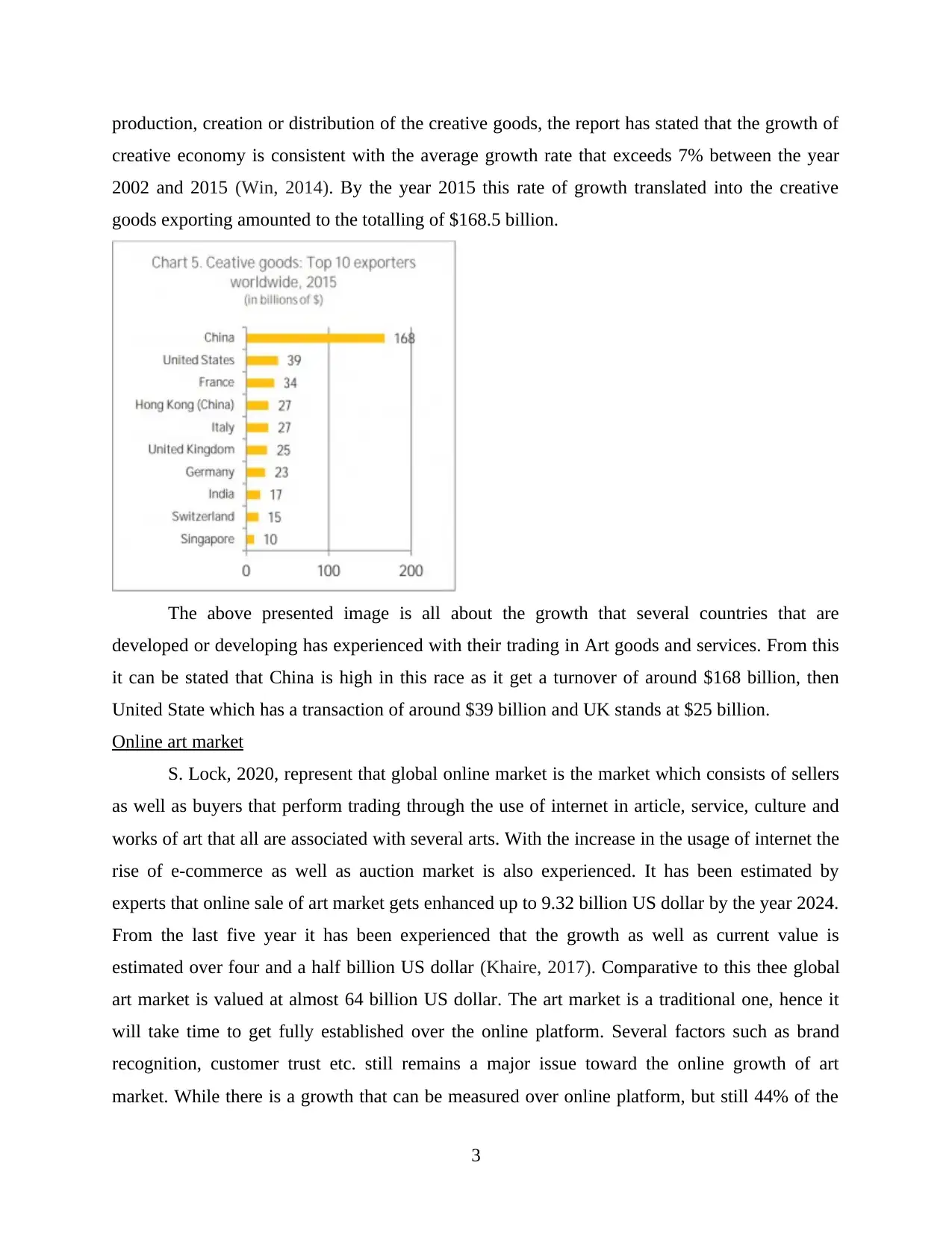
production, creation or distribution of the creative goods, the report has stated that the growth of
creative economy is consistent with the average growth rate that exceeds 7% between the year
2002 and 2015 (Win, 2014). By the year 2015 this rate of growth translated into the creative
goods exporting amounted to the totalling of $168.5 billion.
The above presented image is all about the growth that several countries that are
developed or developing has experienced with their trading in Art goods and services. From this
it can be stated that China is high in this race as it get a turnover of around $168 billion, then
United State which has a transaction of around $39 billion and UK stands at $25 billion.
Online art market
S. Lock, 2020, represent that global online market is the market which consists of sellers
as well as buyers that perform trading through the use of internet in article, service, culture and
works of art that all are associated with several arts. With the increase in the usage of internet the
rise of e-commerce as well as auction market is also experienced. It has been estimated by
experts that online sale of art market gets enhanced up to 9.32 billion US dollar by the year 2024.
From the last five year it has been experienced that the growth as well as current value is
estimated over four and a half billion US dollar (Khaire, 2017). Comparative to this thee global
art market is valued at almost 64 billion US dollar. The art market is a traditional one, hence it
will take time to get fully established over the online platform. Several factors such as brand
recognition, customer trust etc. still remains a major issue toward the online growth of art
market. While there is a growth that can be measured over online platform, but still 44% of the
3
creative economy is consistent with the average growth rate that exceeds 7% between the year
2002 and 2015 (Win, 2014). By the year 2015 this rate of growth translated into the creative
goods exporting amounted to the totalling of $168.5 billion.
The above presented image is all about the growth that several countries that are
developed or developing has experienced with their trading in Art goods and services. From this
it can be stated that China is high in this race as it get a turnover of around $168 billion, then
United State which has a transaction of around $39 billion and UK stands at $25 billion.
Online art market
S. Lock, 2020, represent that global online market is the market which consists of sellers
as well as buyers that perform trading through the use of internet in article, service, culture and
works of art that all are associated with several arts. With the increase in the usage of internet the
rise of e-commerce as well as auction market is also experienced. It has been estimated by
experts that online sale of art market gets enhanced up to 9.32 billion US dollar by the year 2024.
From the last five year it has been experienced that the growth as well as current value is
estimated over four and a half billion US dollar (Khaire, 2017). Comparative to this thee global
art market is valued at almost 64 billion US dollar. The art market is a traditional one, hence it
will take time to get fully established over the online platform. Several factors such as brand
recognition, customer trust etc. still remains a major issue toward the online growth of art
market. While there is a growth that can be measured over online platform, but still 44% of the
3
⊘ This is a preview!⊘
Do you want full access?
Subscribe today to unlock all pages.

Trusted by 1+ million students worldwide
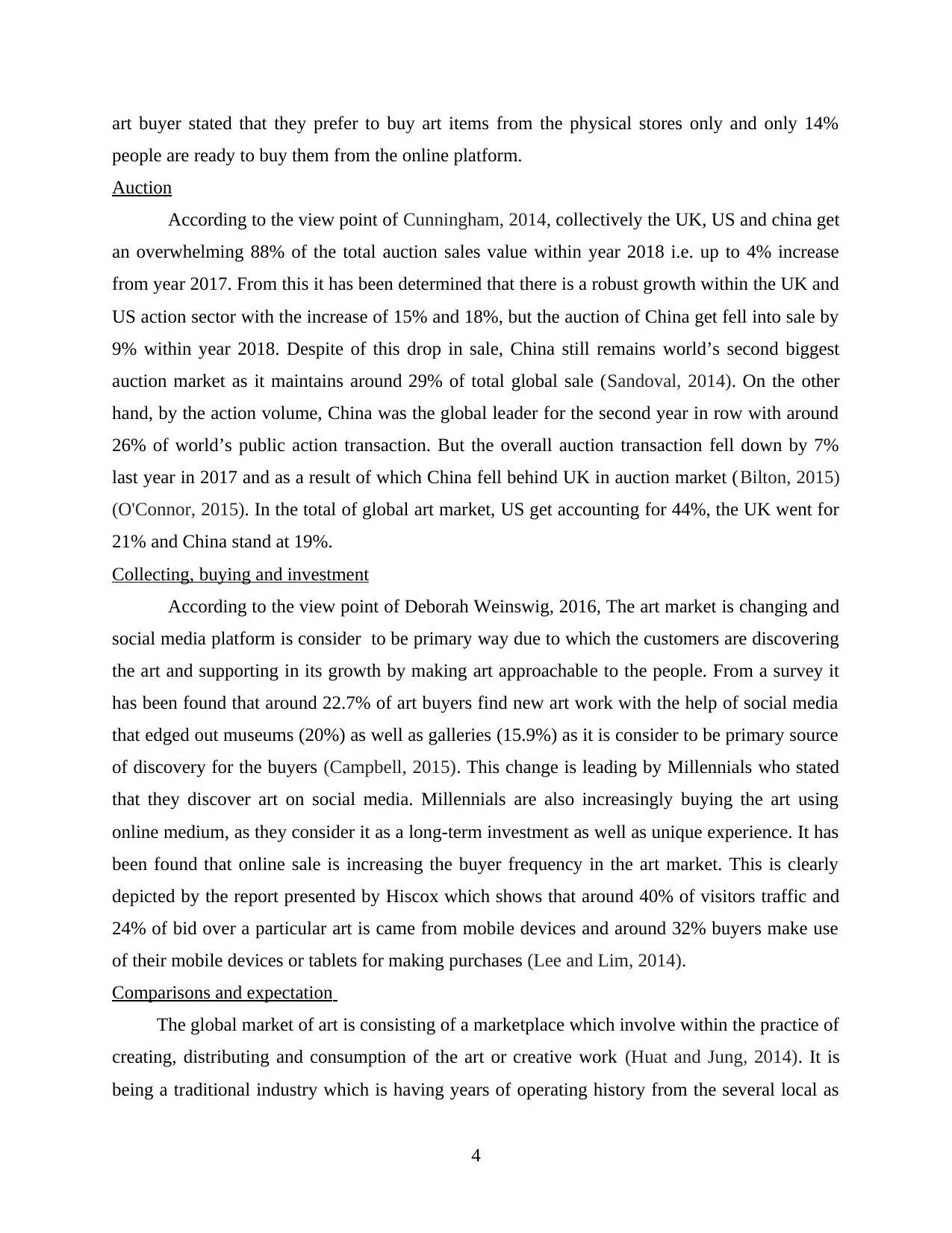
art buyer stated that they prefer to buy art items from the physical stores only and only 14%
people are ready to buy them from the online platform.
Auction
According to the view point of Cunningham, 2014, collectively the UK, US and china get
an overwhelming 88% of the total auction sales value within year 2018 i.e. up to 4% increase
from year 2017. From this it has been determined that there is a robust growth within the UK and
US action sector with the increase of 15% and 18%, but the auction of China get fell into sale by
9% within year 2018. Despite of this drop in sale, China still remains world’s second biggest
auction market as it maintains around 29% of total global sale (Sandoval, 2014). On the other
hand, by the action volume, China was the global leader for the second year in row with around
26% of world’s public action transaction. But the overall auction transaction fell down by 7%
last year in 2017 and as a result of which China fell behind UK in auction market (Bilton, 2015)
(O'Connor, 2015). In the total of global art market, US get accounting for 44%, the UK went for
21% and China stand at 19%.
Collecting, buying and investment
According to the view point of Deborah Weinswig, 2016, The art market is changing and
social media platform is consider to be primary way due to which the customers are discovering
the art and supporting in its growth by making art approachable to the people. From a survey it
has been found that around 22.7% of art buyers find new art work with the help of social media
that edged out museums (20%) as well as galleries (15.9%) as it is consider to be primary source
of discovery for the buyers (Campbell, 2015). This change is leading by Millennials who stated
that they discover art on social media. Millennials are also increasingly buying the art using
online medium, as they consider it as a long-term investment as well as unique experience. It has
been found that online sale is increasing the buyer frequency in the art market. This is clearly
depicted by the report presented by Hiscox which shows that around 40% of visitors traffic and
24% of bid over a particular art is came from mobile devices and around 32% buyers make use
of their mobile devices or tablets for making purchases (Lee and Lim, 2014).
Comparisons and expectation
The global market of art is consisting of a marketplace which involve within the practice of
creating, distributing and consumption of the art or creative work (Huat and Jung, 2014). It is
being a traditional industry which is having years of operating history from the several local as
4
people are ready to buy them from the online platform.
Auction
According to the view point of Cunningham, 2014, collectively the UK, US and china get
an overwhelming 88% of the total auction sales value within year 2018 i.e. up to 4% increase
from year 2017. From this it has been determined that there is a robust growth within the UK and
US action sector with the increase of 15% and 18%, but the auction of China get fell into sale by
9% within year 2018. Despite of this drop in sale, China still remains world’s second biggest
auction market as it maintains around 29% of total global sale (Sandoval, 2014). On the other
hand, by the action volume, China was the global leader for the second year in row with around
26% of world’s public action transaction. But the overall auction transaction fell down by 7%
last year in 2017 and as a result of which China fell behind UK in auction market (Bilton, 2015)
(O'Connor, 2015). In the total of global art market, US get accounting for 44%, the UK went for
21% and China stand at 19%.
Collecting, buying and investment
According to the view point of Deborah Weinswig, 2016, The art market is changing and
social media platform is consider to be primary way due to which the customers are discovering
the art and supporting in its growth by making art approachable to the people. From a survey it
has been found that around 22.7% of art buyers find new art work with the help of social media
that edged out museums (20%) as well as galleries (15.9%) as it is consider to be primary source
of discovery for the buyers (Campbell, 2015). This change is leading by Millennials who stated
that they discover art on social media. Millennials are also increasingly buying the art using
online medium, as they consider it as a long-term investment as well as unique experience. It has
been found that online sale is increasing the buyer frequency in the art market. This is clearly
depicted by the report presented by Hiscox which shows that around 40% of visitors traffic and
24% of bid over a particular art is came from mobile devices and around 32% buyers make use
of their mobile devices or tablets for making purchases (Lee and Lim, 2014).
Comparisons and expectation
The global market of art is consisting of a marketplace which involve within the practice of
creating, distributing and consumption of the art or creative work (Huat and Jung, 2014). It is
being a traditional industry which is having years of operating history from the several local as
4
Paraphrase This Document
Need a fresh take? Get an instant paraphrase of this document with our AI Paraphraser
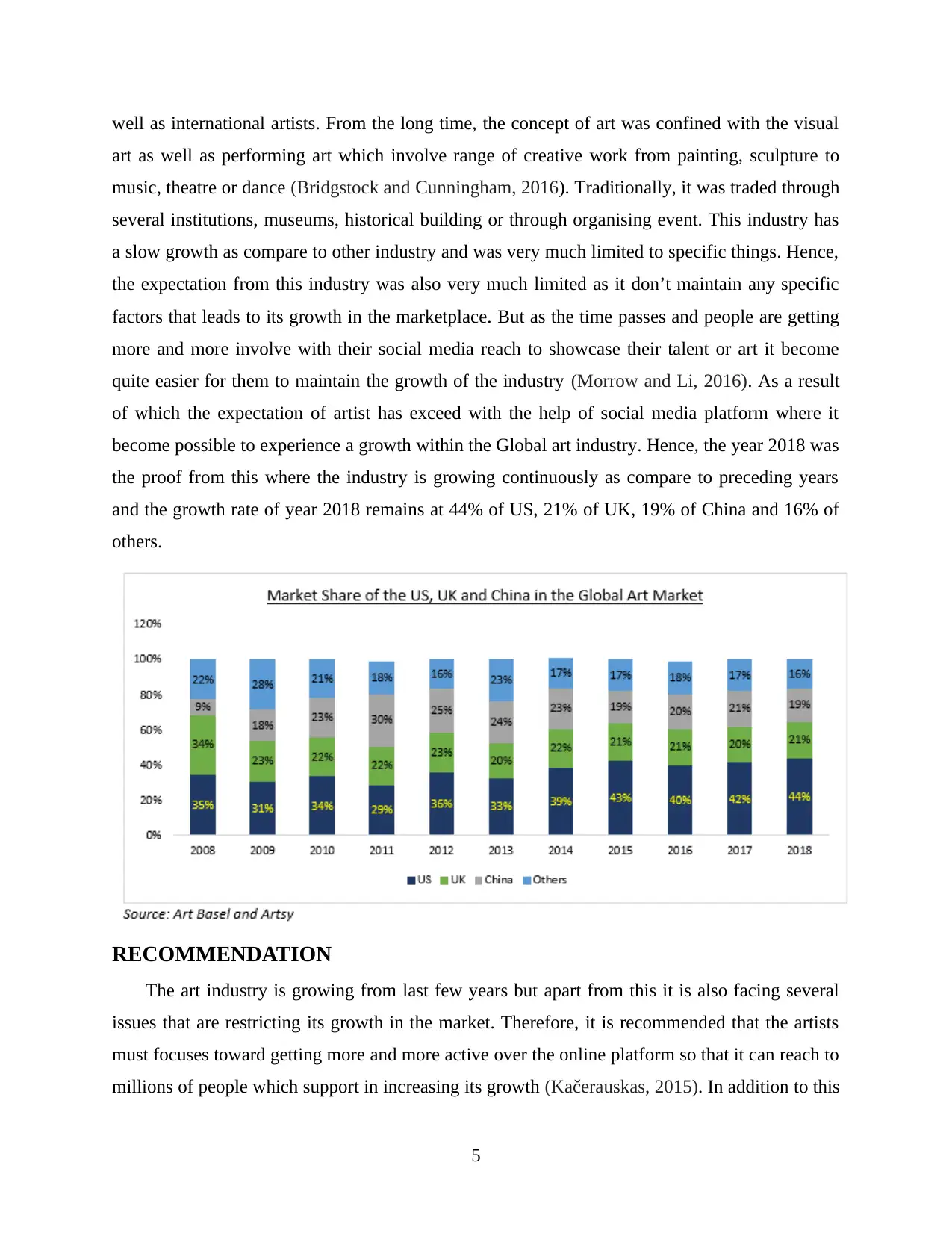
well as international artists. From the long time, the concept of art was confined with the visual
art as well as performing art which involve range of creative work from painting, sculpture to
music, theatre or dance (Bridgstock and Cunningham, 2016). Traditionally, it was traded through
several institutions, museums, historical building or through organising event. This industry has
a slow growth as compare to other industry and was very much limited to specific things. Hence,
the expectation from this industry was also very much limited as it don’t maintain any specific
factors that leads to its growth in the marketplace. But as the time passes and people are getting
more and more involve with their social media reach to showcase their talent or art it become
quite easier for them to maintain the growth of the industry (Morrow and Li, 2016). As a result
of which the expectation of artist has exceed with the help of social media platform where it
become possible to experience a growth within the Global art industry. Hence, the year 2018 was
the proof from this where the industry is growing continuously as compare to preceding years
and the growth rate of year 2018 remains at 44% of US, 21% of UK, 19% of China and 16% of
others.
RECOMMENDATION
The art industry is growing from last few years but apart from this it is also facing several
issues that are restricting its growth in the market. Therefore, it is recommended that the artists
must focuses toward getting more and more active over the online platform so that it can reach to
millions of people which support in increasing its growth (Kačerauskas, 2015). In addition to this
5
art as well as performing art which involve range of creative work from painting, sculpture to
music, theatre or dance (Bridgstock and Cunningham, 2016). Traditionally, it was traded through
several institutions, museums, historical building or through organising event. This industry has
a slow growth as compare to other industry and was very much limited to specific things. Hence,
the expectation from this industry was also very much limited as it don’t maintain any specific
factors that leads to its growth in the marketplace. But as the time passes and people are getting
more and more involve with their social media reach to showcase their talent or art it become
quite easier for them to maintain the growth of the industry (Morrow and Li, 2016). As a result
of which the expectation of artist has exceed with the help of social media platform where it
become possible to experience a growth within the Global art industry. Hence, the year 2018 was
the proof from this where the industry is growing continuously as compare to preceding years
and the growth rate of year 2018 remains at 44% of US, 21% of UK, 19% of China and 16% of
others.
RECOMMENDATION
The art industry is growing from last few years but apart from this it is also facing several
issues that are restricting its growth in the market. Therefore, it is recommended that the artists
must focuses toward getting more and more active over the online platform so that it can reach to
millions of people which support in increasing its growth (Kačerauskas, 2015). In addition to this
5
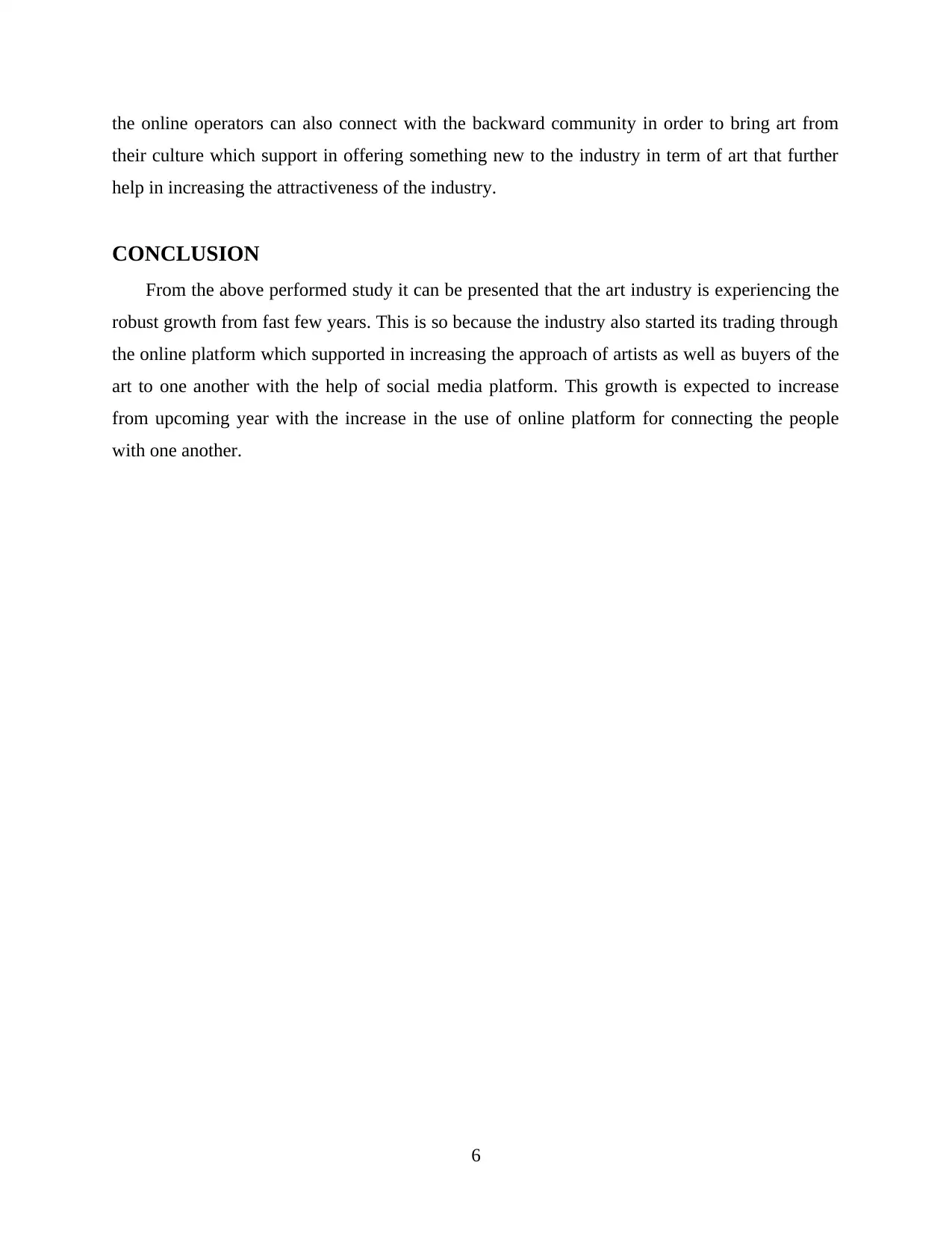
the online operators can also connect with the backward community in order to bring art from
their culture which support in offering something new to the industry in term of art that further
help in increasing the attractiveness of the industry.
CONCLUSION
From the above performed study it can be presented that the art industry is experiencing the
robust growth from fast few years. This is so because the industry also started its trading through
the online platform which supported in increasing the approach of artists as well as buyers of the
art to one another with the help of social media platform. This growth is expected to increase
from upcoming year with the increase in the use of online platform for connecting the people
with one another.
6
their culture which support in offering something new to the industry in term of art that further
help in increasing the attractiveness of the industry.
CONCLUSION
From the above performed study it can be presented that the art industry is experiencing the
robust growth from fast few years. This is so because the industry also started its trading through
the online platform which supported in increasing the approach of artists as well as buyers of the
art to one another with the help of social media platform. This growth is expected to increase
from upcoming year with the increase in the use of online platform for connecting the people
with one another.
6
⊘ This is a preview!⊘
Do you want full access?
Subscribe today to unlock all pages.

Trusted by 1+ million students worldwide
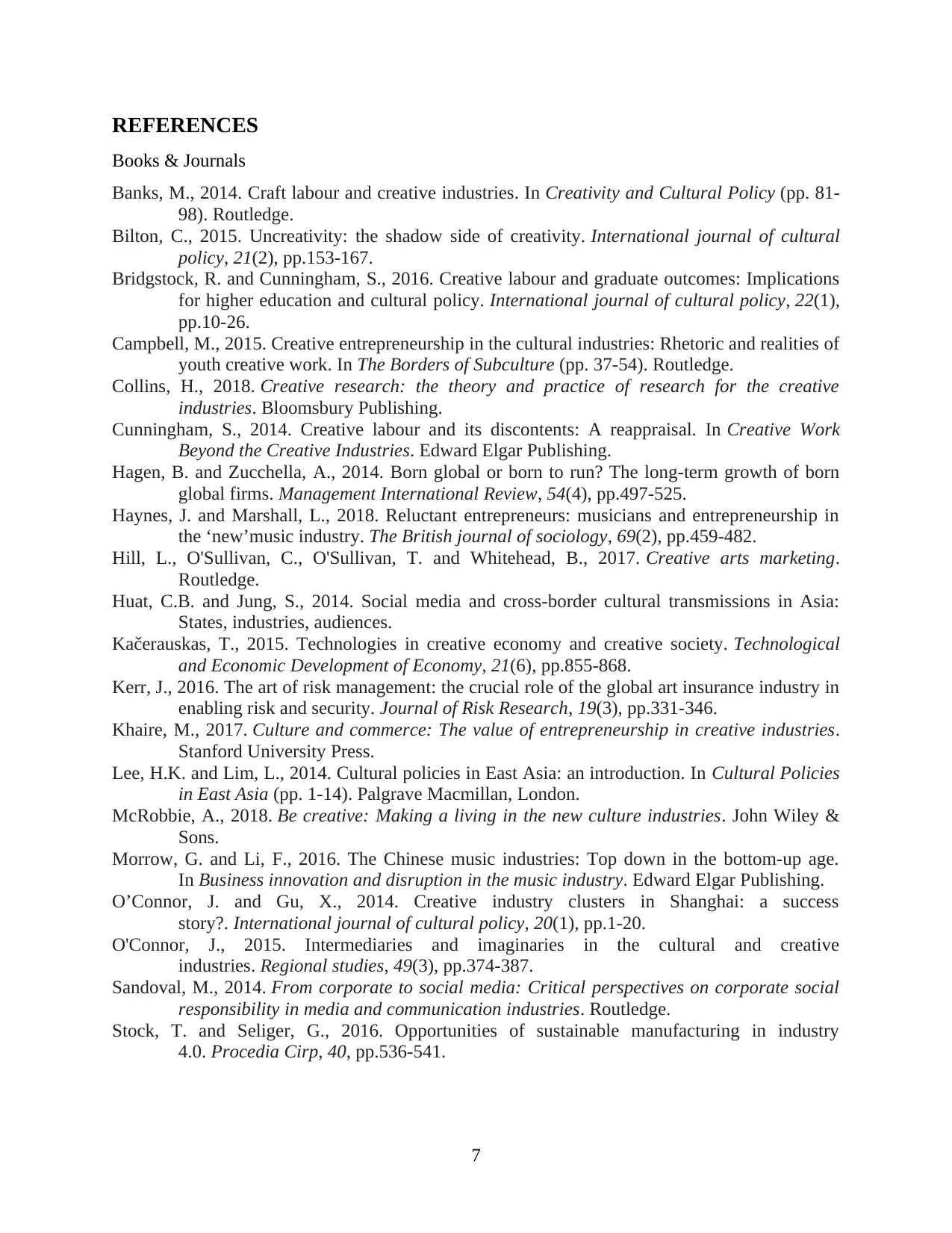
REFERENCES
Books & Journals
Banks, M., 2014. Craft labour and creative industries. In Creativity and Cultural Policy (pp. 81-
98). Routledge.
Bilton, C., 2015. Uncreativity: the shadow side of creativity. International journal of cultural
policy, 21(2), pp.153-167.
Bridgstock, R. and Cunningham, S., 2016. Creative labour and graduate outcomes: Implications
for higher education and cultural policy. International journal of cultural policy, 22(1),
pp.10-26.
Campbell, M., 2015. Creative entrepreneurship in the cultural industries: Rhetoric and realities of
youth creative work. In The Borders of Subculture (pp. 37-54). Routledge.
Collins, H., 2018. Creative research: the theory and practice of research for the creative
industries. Bloomsbury Publishing.
Cunningham, S., 2014. Creative labour and its discontents: A reappraisal. In Creative Work
Beyond the Creative Industries. Edward Elgar Publishing.
Hagen, B. and Zucchella, A., 2014. Born global or born to run? The long-term growth of born
global firms. Management International Review, 54(4), pp.497-525.
Haynes, J. and Marshall, L., 2018. Reluctant entrepreneurs: musicians and entrepreneurship in
the ‘new’music industry. The British journal of sociology, 69(2), pp.459-482.
Hill, L., O'Sullivan, C., O'Sullivan, T. and Whitehead, B., 2017. Creative arts marketing.
Routledge.
Huat, C.B. and Jung, S., 2014. Social media and cross-border cultural transmissions in Asia:
States, industries, audiences.
Kačerauskas, T., 2015. Technologies in creative economy and creative society. Technological
and Economic Development of Economy, 21(6), pp.855-868.
Kerr, J., 2016. The art of risk management: the crucial role of the global art insurance industry in
enabling risk and security. Journal of Risk Research, 19(3), pp.331-346.
Khaire, M., 2017. Culture and commerce: The value of entrepreneurship in creative industries.
Stanford University Press.
Lee, H.K. and Lim, L., 2014. Cultural policies in East Asia: an introduction. In Cultural Policies
in East Asia (pp. 1-14). Palgrave Macmillan, London.
McRobbie, A., 2018. Be creative: Making a living in the new culture industries. John Wiley &
Sons.
Morrow, G. and Li, F., 2016. The Chinese music industries: Top down in the bottom-up age.
In Business innovation and disruption in the music industry. Edward Elgar Publishing.
O’Connor, J. and Gu, X., 2014. Creative industry clusters in Shanghai: a success
story?. International journal of cultural policy, 20(1), pp.1-20.
O'Connor, J., 2015. Intermediaries and imaginaries in the cultural and creative
industries. Regional studies, 49(3), pp.374-387.
Sandoval, M., 2014. From corporate to social media: Critical perspectives on corporate social
responsibility in media and communication industries. Routledge.
Stock, T. and Seliger, G., 2016. Opportunities of sustainable manufacturing in industry
4.0. Procedia Cirp, 40, pp.536-541.
7
Books & Journals
Banks, M., 2014. Craft labour and creative industries. In Creativity and Cultural Policy (pp. 81-
98). Routledge.
Bilton, C., 2015. Uncreativity: the shadow side of creativity. International journal of cultural
policy, 21(2), pp.153-167.
Bridgstock, R. and Cunningham, S., 2016. Creative labour and graduate outcomes: Implications
for higher education and cultural policy. International journal of cultural policy, 22(1),
pp.10-26.
Campbell, M., 2015. Creative entrepreneurship in the cultural industries: Rhetoric and realities of
youth creative work. In The Borders of Subculture (pp. 37-54). Routledge.
Collins, H., 2018. Creative research: the theory and practice of research for the creative
industries. Bloomsbury Publishing.
Cunningham, S., 2014. Creative labour and its discontents: A reappraisal. In Creative Work
Beyond the Creative Industries. Edward Elgar Publishing.
Hagen, B. and Zucchella, A., 2014. Born global or born to run? The long-term growth of born
global firms. Management International Review, 54(4), pp.497-525.
Haynes, J. and Marshall, L., 2018. Reluctant entrepreneurs: musicians and entrepreneurship in
the ‘new’music industry. The British journal of sociology, 69(2), pp.459-482.
Hill, L., O'Sullivan, C., O'Sullivan, T. and Whitehead, B., 2017. Creative arts marketing.
Routledge.
Huat, C.B. and Jung, S., 2014. Social media and cross-border cultural transmissions in Asia:
States, industries, audiences.
Kačerauskas, T., 2015. Technologies in creative economy and creative society. Technological
and Economic Development of Economy, 21(6), pp.855-868.
Kerr, J., 2016. The art of risk management: the crucial role of the global art insurance industry in
enabling risk and security. Journal of Risk Research, 19(3), pp.331-346.
Khaire, M., 2017. Culture and commerce: The value of entrepreneurship in creative industries.
Stanford University Press.
Lee, H.K. and Lim, L., 2014. Cultural policies in East Asia: an introduction. In Cultural Policies
in East Asia (pp. 1-14). Palgrave Macmillan, London.
McRobbie, A., 2018. Be creative: Making a living in the new culture industries. John Wiley &
Sons.
Morrow, G. and Li, F., 2016. The Chinese music industries: Top down in the bottom-up age.
In Business innovation and disruption in the music industry. Edward Elgar Publishing.
O’Connor, J. and Gu, X., 2014. Creative industry clusters in Shanghai: a success
story?. International journal of cultural policy, 20(1), pp.1-20.
O'Connor, J., 2015. Intermediaries and imaginaries in the cultural and creative
industries. Regional studies, 49(3), pp.374-387.
Sandoval, M., 2014. From corporate to social media: Critical perspectives on corporate social
responsibility in media and communication industries. Routledge.
Stock, T. and Seliger, G., 2016. Opportunities of sustainable manufacturing in industry
4.0. Procedia Cirp, 40, pp.536-541.
7
Paraphrase This Document
Need a fresh take? Get an instant paraphrase of this document with our AI Paraphraser
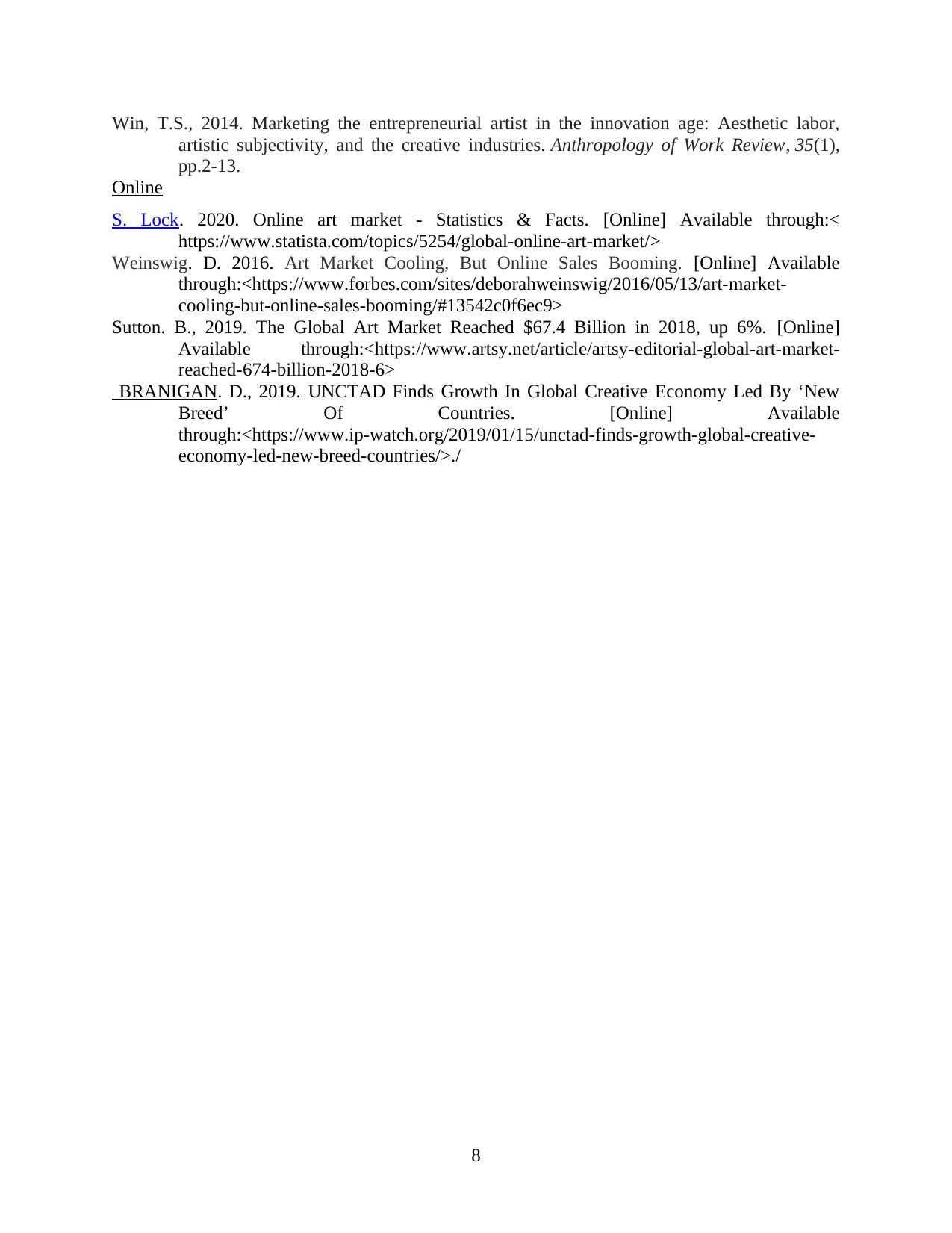
Win, T.S., 2014. Marketing the entrepreneurial artist in the innovation age: Aesthetic labor,
artistic subjectivity, and the creative industries. Anthropology of Work Review, 35(1),
pp.2-13.
Online
S. Lock. 2020. Online art market - Statistics & Facts. [Online] Available through:<
https://www.statista.com/topics/5254/global-online-art-market/>
Weinswig. D. 2016. Art Market Cooling, But Online Sales Booming. [Online] Available
through:<https://www.forbes.com/sites/deborahweinswig/2016/05/13/art-market-
cooling-but-online-sales-booming/#13542c0f6ec9>
Sutton. B., 2019. The Global Art Market Reached $67.4 Billion in 2018, up 6%. [Online]
Available through:<https://www.artsy.net/article/artsy-editorial-global-art-market-
reached-674-billion-2018-6>
BRANIGAN. D., 2019. UNCTAD Finds Growth In Global Creative Economy Led By ‘New
Breed’ Of Countries. [Online] Available
through:<https://www.ip-watch.org/2019/01/15/unctad-finds-growth-global-creative-
economy-led-new-breed-countries/>./
8
artistic subjectivity, and the creative industries. Anthropology of Work Review, 35(1),
pp.2-13.
Online
S. Lock. 2020. Online art market - Statistics & Facts. [Online] Available through:<
https://www.statista.com/topics/5254/global-online-art-market/>
Weinswig. D. 2016. Art Market Cooling, But Online Sales Booming. [Online] Available
through:<https://www.forbes.com/sites/deborahweinswig/2016/05/13/art-market-
cooling-but-online-sales-booming/#13542c0f6ec9>
Sutton. B., 2019. The Global Art Market Reached $67.4 Billion in 2018, up 6%. [Online]
Available through:<https://www.artsy.net/article/artsy-editorial-global-art-market-
reached-674-billion-2018-6>
BRANIGAN. D., 2019. UNCTAD Finds Growth In Global Creative Economy Led By ‘New
Breed’ Of Countries. [Online] Available
through:<https://www.ip-watch.org/2019/01/15/unctad-finds-growth-global-creative-
economy-led-new-breed-countries/>./
8
1 out of 11
Related Documents
Your All-in-One AI-Powered Toolkit for Academic Success.
+13062052269
info@desklib.com
Available 24*7 on WhatsApp / Email
![[object Object]](/_next/static/media/star-bottom.7253800d.svg)
Unlock your academic potential
Copyright © 2020–2025 A2Z Services. All Rights Reserved. Developed and managed by ZUCOL.





